The uninterrupted operation of the engine is the key to the long operational period of any car. Any incorrect engine operation can lead to long and, more importantly, costly repair. Therefore, it is so important in time and properly carry out the engine maintenance and monitor the wear of its parts, as the wear of the parts is one of the most frequent causes of the breakdown. The late oil change can subsequently lead to serious breakdowns and excessive wear of engine parts, not to mention the increase in fuel consumption. Such, it would seem, a simple step is a timely replacement and the correct selection of oil, at times increases the life of any engine.
Content
Classification of motor oils
Classify motor oils It is possible by the main characteristics:
- oil application area (intended for gasoline or diesel engines or universal),
- viscosity (classification of oil viscosity (taking into account changes in the viscosity of the oil when the ambient temperature changes); distinguish all-season (most popular in the CIS and Europe), winter and summer oils),
- type (determined depending on the method of production and source raw materials; distinguish between mineral, semi-synthetic and synthetic oils).
Oil classification
Mineral oils consist of a mixture of various hydrocarbons.
Mineral engine oils made of heavy high-boiling oil fractions.
To improve the quality of mineral oil, it is subjected to special processing to restructure molecules (called hydrocracking) of high temperature and high pressure with the addition of catalysts and hydrogen. This process is improved all the time, and modern mineral oils differ significantly higher quality compared to their predecessors produced 10 or more years ago.
Synthetic oils are manufactured by chemical synthesis. Synthetic oils differ from mineral with higher homogeneity and increased stability.
as an example, you can consider the effect of temperature on the properties of mineral and synthetic oils
Mineral oils are subject to increased temperature effects and require the use of special additives, but this leads to a decrease in the life of oil and, as a result, more frequent replacing it. Synthetic oils are less dependent on temperatures and allow sufficient density and viscosity both under negative temperatures and with elevated, which ensures a decrease in the wear of parts and, in general, ensures fuel economy.
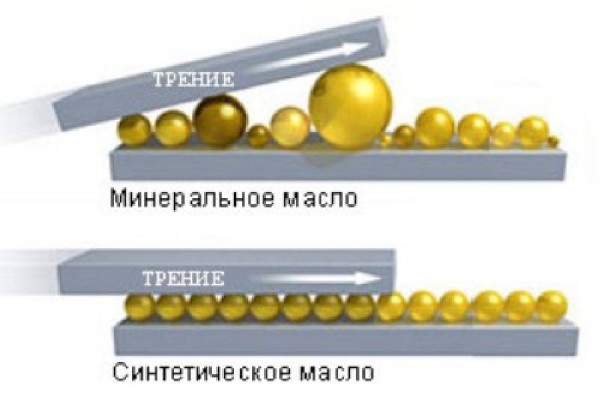
It is necessary to replace the synthetic oils less often, however, the price of such oils is often an order of magnitude higher compared to other types of engine oils due to the high costs used for the production of raw materials and equipment.
Despite all the advantages of using synthetic oils, they can be used not for all engines.
For example, for old cars (with the engines with the gland padding), the use of such an oil is unacceptable.
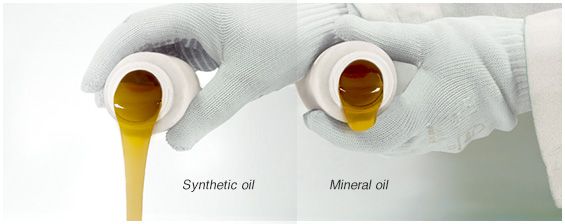
There is also a third (intermediate) type - semi-synthetic engine oils obtained by mixing mineral and synthetic oils. Such oils in their technical characteristics are better than mineral (above the viscosity index, less predisposition to the formation of deposits during operation at high temperatures, etc.). Semi-synthetic oils provide better (compared to clean mineral oil) engine protection and reduce fuel consumption (on average by 3-5%). The price of semi-synthetic oils is below synthetic, which makes them very popular among consumers.
oil additives in the engine
High requirements for the quality of lubricating characteristics of the engine oil led to the appearance of a huge number of additives, which are added to the oil to improve its properties.
Often, oil can contain several types of additives at once, each of which affects a specific oil property.
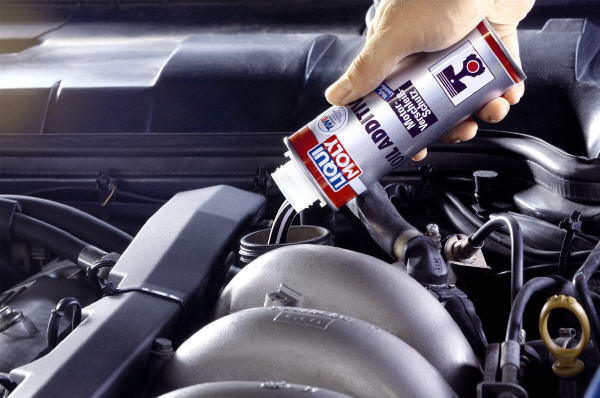
For example, the addition of "detergent" additive does not allow the burning of parts, in particular piston rings, etc., and also purifies and reduces deposits on the details of the oil film, the so-called "varnish", the anti-wear additive allows you to reduce the wear of rubbing parts, forging more Resistant oil film on the friction surface.
Depending on the goals and the needs of the engine, you can choose the optimal engine oil with the necessary properties due to the optimally selected combination of additives.
In the modern market, customers are offered many different additives and additives that can be added to the engine oil. However, with such additives should be extremely careful because improving one property of the engine oil, we can significantly worsen another. For example, adding a washing additive to clean the engine, we can worsen the anti-wear oil properties and, as a result, provoke excessive wear of the engine components.
Classification of motor oil by viscosity
Oil viscosity Determined according to the Methodology of the SAE automotive engineers society.
Marking According to the SAE classification consists of letters and numbers or only numbers.
Consider how to decipher this marking and what viscosity oil to choose for your car.
Summer grades of engine oil contain only numbers (20, 30, 40, 50 and 60) in the viscosity labeling. Letter W (from English Worder Words - Winter) - Indicates Winter Sort Oil. The SAE J300 standard lists 6 viscosity classes for winter varieties of oil (OW, 5W, 10W, 15W, 20W, 25W).

It is worth noting that mineral oils the freezing temperature is an order of magnitude higher compared to synthetic oils and it should be taken into account when choosing an oil in the regions with harsh winter.
For example, in the regions where in the winter the temperature may drop below -30 ° C it is recommended to use synthetic or at least half-synthetic oil to prevent its freezing.
Some synthetic oils can be launched the engine and at -40 ° C, since they have a freezing temperature below -50 ° C, while mineral oil thickens and can completely freeze at -30-35 ° C.
Most of the average drivers change the oil on average once a year, so all-season motor oil varieties are most popular and distributed in countries with temperate climates and a relatively small seasonal temperature drop.
Marking of all-season oil contains both a winter and summer viscosity indicator, which are usually indicated through a dash, a hyphen or a space (for example, SAE 10W30, SAE 15W-40, etc.).
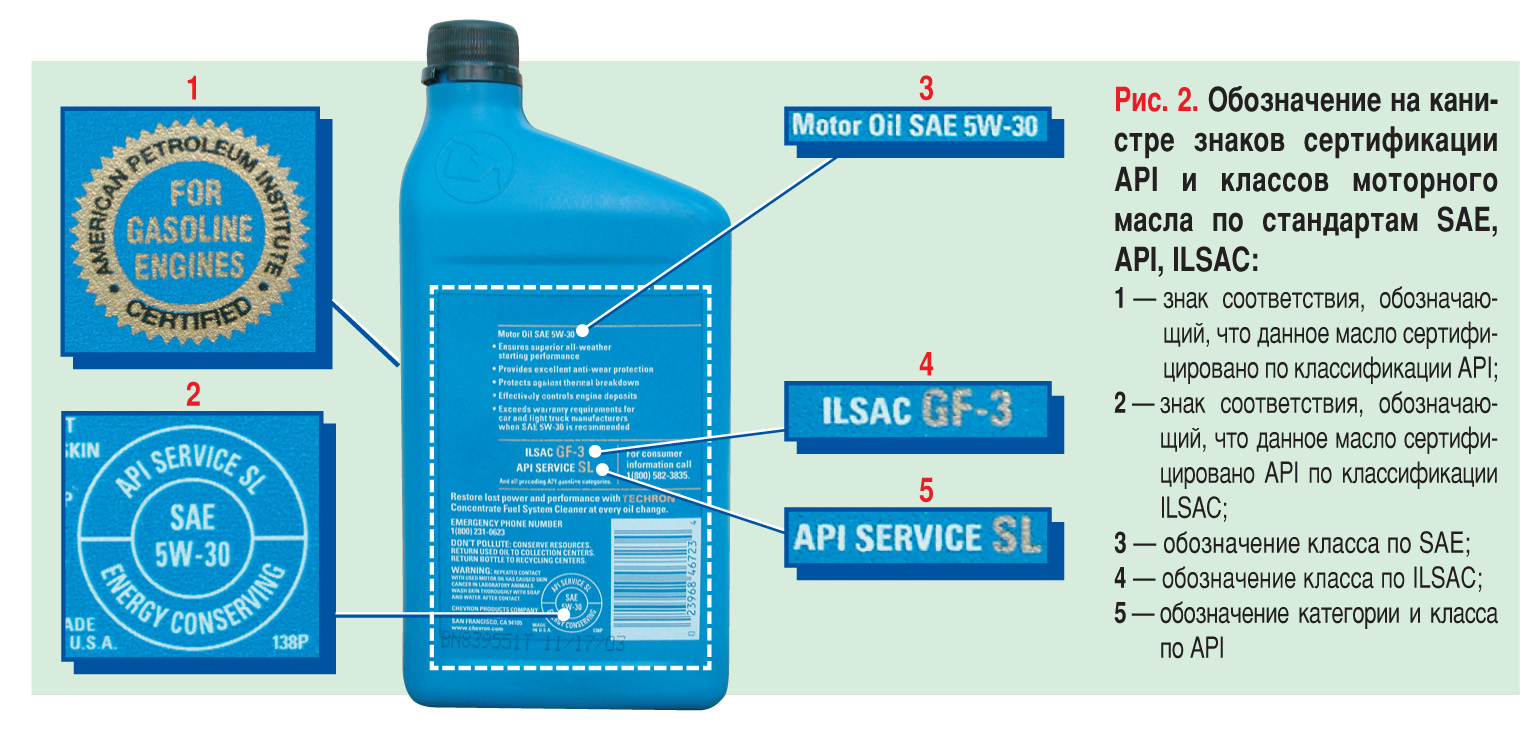
It is worth paying attention to that synthetic oils are more flowable, they are easier distributed through the oil system and can easier penetrate the gaps and not enough dense compounds and detect the leakage of oil is the easiest way to use synthetic oil.
For example, the leakage leakage, which many is written off on excessive oil aggressiveness, often signals the wear of the cuff edge and the need to replace it.
When using mineral or semi-synthetic oils, it is worth more attentive to examine the elements of the engine for wear and density of the connections.
Classification by level of operational properties and oil conditions
In addition to viscosity and type of oil, there is also a classification on the levels of operational properties and the conditions of oil use.
This classification was proposed by API (American Petroleum Institute - American Oil Institute) in 1947.
Fucking a few changes and additions This classification is used to this day.
According to this classification, oil is divided into 2 categories: "S" (Service) and "C" (Commercial).
Oils with marking S are used for four-stroke gasoline engines, and with marking C - for agricultural machinery, road construction equipment and other oversized vehicles.
The category "S" is divided into several classes ascending requirements for quality oil characteristics: API SA, API SB, API SC, API SD, API SE, API SF, API SG, API SH and API SJ, API SL, API SM. To date, not all of the listed categories are used, some of them are already recognized as outdated and no longer apply.
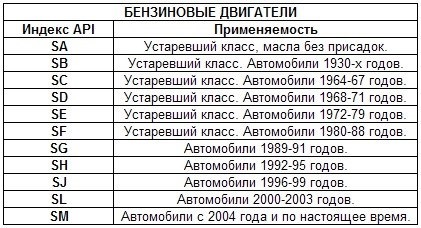
In particular, the following classes of category "S" are no longer used:
- SA (oils without additional additives suitable for use in gasoline and diesel engines),
- SG (for gasoline engines released in the late 80s - early 90s),
- SB (oils with light antioxidative and anti-wear protection for low-power gasoline engines),
- SF (for gasoline engines of the release of the 80s),
- SC (for gasoline and diesel engines of the old sample, which were released in the 60s),
- SE (for use in the gasoline engines of the release of 72-79 years, additionally have in the additives from nagar, corrosion and oxidation),
- SD (for gasoline engines of passenger cars of the end of the 60s).
There are also two more relative to new oil classes for modern cars - SL and SM.
SL oil oils can be used in turbocharged multi-chamber engines (especially relevant use of this oil when working with depleted fuel mixtures), the SM class is characterized by higher antioxidant and anti-wear properties due to the presence of additional additives.
The category "C" includes ten classes: CA, SV, SS, CD, CD-II, CE, CF, CF-2, CF-4 and CG-4. Classes API CA, API CB, API CC, API CD, CD-II API are considered already outdated and are no longer used at the moment.
However, on the store shelves, it is still possible to meet oils with marking of obsolete classes, since cars with old engines are still in operation and therefore manufacturers continue to produce motor oils for them.
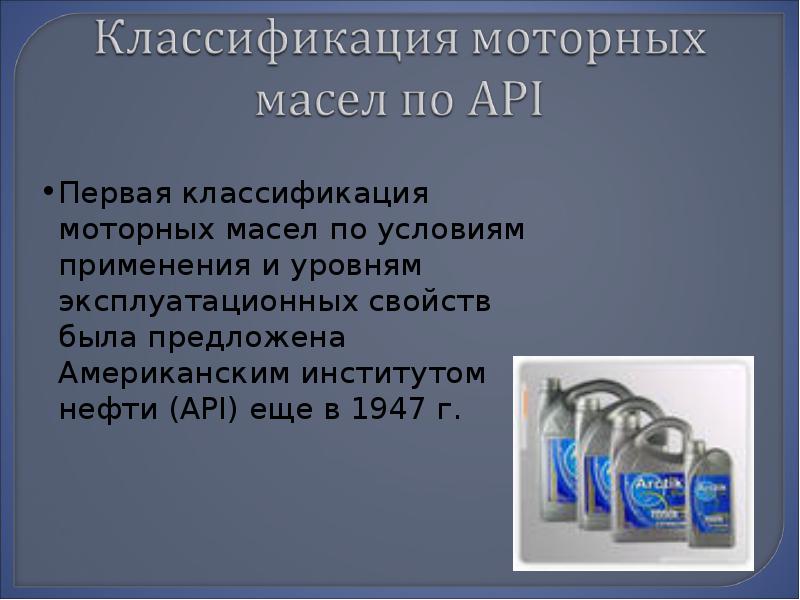
There is also a double marking (for example, SF / CC, SG / CD, SJ / SF-4, etc.), which is denoted by universal oil, which can be safely used with the same efficiency both on gasoline and diesel engines.
Classification of oils based on test methods
Since 1996, the European Association of Automotive Representatives (ACEA), which includes the global car industry giants as Fiat, Peugeot, BMW, Volksvagen, Porsche, General Motors Europe, Volvo, etc., was introduced a new classification of oils based on Test methods.
The classification of ACEA-98 contains 3 categories of motor oils depending on their purpose - A, B and E:
- category A used to designate oil quality levels for gasoline engines. This category consists of three subcategories - A1, A2, A3.
- category B is used to designate oil quality levels for diesel engines in small vans and passenger cars.
This category consists of three subcategories - B2, B3 and B4.
- category E is used to indicate oil quality levels for use in heavy diesel engines, which are often used in large cargo vehicles.
This category consists of three subcategories - E1, E2, E3 and E4.
Basic guidelines for the choice of engine oil
Given the huge range of oils on the market, it is very important to be able to choose the right oil.
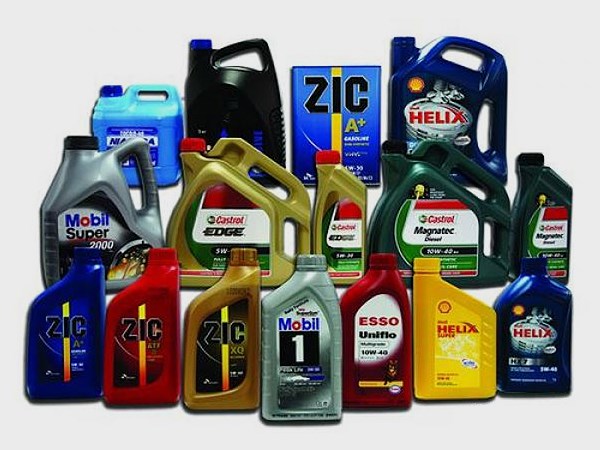
First of all, it is necessary to be guided by the recommendations for the selection of oil in the operating instructions for the car.
The main characteristics that are worth navigating when choosing an oil:
- viscosity (based on the climatic zone and season of operation of the equipment),
- application type (based on oil selection recommendations from the manufacturer of the equipment specified in the instruction manual or, possibly, the car service book, and also considering the type and mode of operation of the engine).
Several major generalized oil selection recommendations:
- For new cars (when running up to a quarter from a complete stated engine resource), it is recommended to use oil with a viscosity of 10W30 or 5W30 throughout the year.
- After a quarter of a quarter of the planned engine resource, it is worth applying an oil viscosity SAE 5W40 all year round, or, if possible, to replace the oil twice a year and in the summer, use oils with marking 15W40 or 10W40, and in winter - 5W30 or 10W30.
- For supported cars (after a run of three fourths from the engine's planned resource), it's worth moving onto oil with SAE 5W40 labeling (all-season) or use SAE 10W40 or SAE 5W40 in winter and 20W40 or 15W40 in summer.
- For cars operated under conditions of harsh winter (if the temperature drops to minus 25-30 ° C and below) it is worth using a semi-synthetic or synthetic oil to avoid freezing.
- For vehicles operated in difficult conditions, it is necessary to replace the oil more often at 1.5, or even twice.
- You can not add other type oil into the engine and even the oil of the same labeling, but another manufacturer.
- The oil of one marking from different manufacturers may differ in terms of the number and composition of the additives in it, and the mixing of different types of oil can significantly worsen its operational characteristics.
- It is impossible to mix synthetic and mineral because of their different density.When moving from one type of oil to another, before the fill of the new oil, it is recommended to wash the oil system using a special cleansing composition.
- When replacing the oil, it is recommended to replace the oil filter.
This is not a prerequisite, however, the implementation of this recommendation can significantly extend the operational period of the engine and this will undoubtedly help avoid clogging of the oil system.
Related Materials
- Stove 2110, bad warm stove 2110, VAZ 2110 heating system, repairing the heating system VAZ 2110 with their own hands
- VAZ 2114 stove blows with cold air, stove 2114, bad warm stove VAZ 2114, device and repair of heating VAZ 2114 do-it-yourself, removing the stove VAZ 2114
- How to subdominize the car. How to put a jack. Types of jacks for cars.
- VAZ 2109 Fuse Block, VAZ 2109 Fuse Block Carburetor, VAZ 2109 Fuse Block Injector, Old VAZ 2109 Fuse Block, VAZ 2109 Fuse Block, VAZ Fuse Block 2109
- Car exhaust gas catalyst, faulty catalyst, pluses and cons of the catalyst, how to change the catalyst for the planeencitel
- Stove blowing cold air VAZ 2114, badly blowing the stove VAZ 2114, why badly blowing the stove VAZ 2114
- How to find out the owner of the car by the number of his car, check the car by the number of the traffic police machine, check the car by the state number of the car for free
- How to choose Used tires, Useful Tips
- Winter car road, pressure in passenger car tires in winter, good battery for the car in winter, whether to warm the car in winter
- In winter, the car is poorly started. How to make a car in winter, do you need to warm up the car in winter, useful tips
- Economy fuel consumption machines, the most economical car consumption
- Tires brands for passenger cars, labeling of car tire labeling, residual passenger car tire protector, how to pick a tire on a car brand, car tire tread pattern
- Working transmission operation, mechanical gearbox clutch work, driving with manual gearbox, useful tips
- Rear beam Peugeot 206 sedan, rear beam device Peugeot 206. Rear beam Peugeot 206 Malfunction, repair of the rear beam Peugeot 206
- Diesel fuel in winter, additive for diesel fuel in winter, how to choose the best diesel fuel
- Diesel winter does not start. How to start diesel in winter, heating diesel in winter.
- Japanese bridgestone tires, winter studded bridgestone tires, bridgestone tires brand
- Tire marking decoding for passenger cars, labeling wheels, how to choose the right tires on the disks
- Diesel engine in winter, launch of the diesel engine in winter, what oil to fill in a diesel engine in winter, useful tips
- LED backlight of the car, the backlight of the bottom of the car, the backlight of the legs in the car, the backlight in the door of the car, the backlight of the car is fine
- Recovered tires, bus tire, restored tire protector, can I use them
- Choose winter tires, which is a winter tires, which pressure in winter tires should be marked with winter tires, how to choose the right winter tires, the best winter tires 2019
- Steering rail rail, knock of steering rack, reasons for the knock and repair of the steering rack do it yourself
- Cameless car tires, a set for repair of tubeless tires, repair of the cannon-free tire do it yourself
- Russian tires, Russian tires Winter, Russian All-season tires, Voronezh AMTEL tires, Tires "Matador Omsk Tire", Kama-tires are world-class bus
- How to open a car without a key. Lost the key from the car what to do, the key from the car inside the car
- Silent tires, quiet winter tires, quiet studded bus, which tires to choose, overview tires
- Tires and safety, safety of the bus, why it is necessary to constantly monitor car tires
- Rules of safe driving of the car in the rain and slush, safe driving of the car for beginners
- Rust converter which is better for cars, rust converters to choose how to use rust transducer, professionals
- Polishing the body of the car do it yourself, how to choose a polishing paste, useful tips
- Engine durability, engine life, how to extend engine life
- Knock in the car. Knock when moving the car. What can knock in the car. How to determine the cause of the knock.
- ABS car, what is ABS car, ABS system malfunction, ABS diagnostics
- Overtaking a car when you can start overtaking a car, rules of traffic rules
- Fuel pump VAZ 2110, VAZ 2110 gas station scheme, VAZ 2110 fuel pump device, VAZ 2110 gas station repair,
- Automotive antennas for radio, automotive antenna device, car antenna do it yourself
- Front suspension Kalina, device front suspension Kalina, knock in front suspension Kalina, repair of front suspension Kalina
- Shock absorber Oil, best oil shock absorbers, pumping oil shock absorbers, how to properly pump oil shock absorber
- Clutch malfunctions, touches clutch, causes a clutch malfunction, how to eliminate
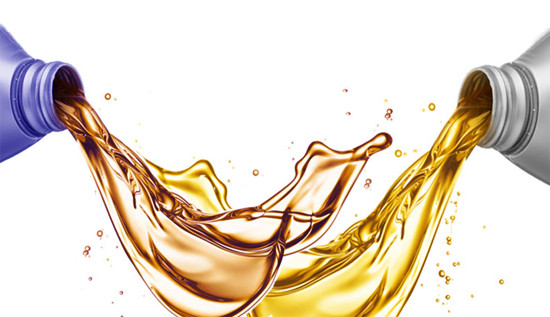






For myself, I have long decided on the engine oil, I made a choice in favor of German quality, this is Rolf GT 5W40 oil. I fill it for 3 years, TTT has no problems have not yet arose with the engine as a whole. Yes, and the price is excellent, 1400 for 4l.